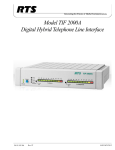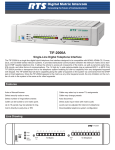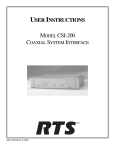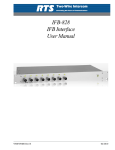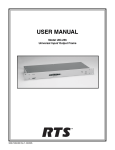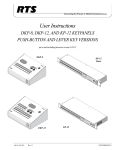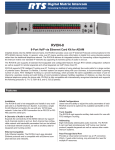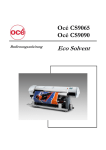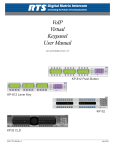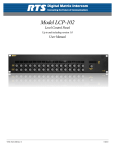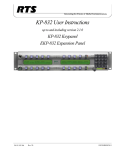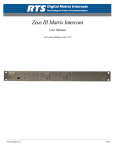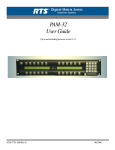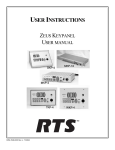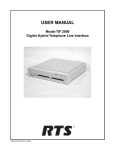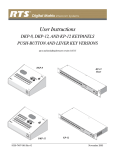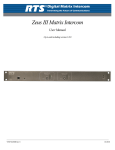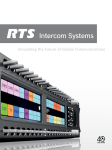Download Model TIF 2000A Digital Hybrid Telephone Line Interface
Transcript
Model TIF 2000A Digital Hybrid Telephone Line Interface 9350-7823-000 Rev E SEPT/2009 PROPRIETARY NOTICE SHIPPING TO THE MANUFACTURER The product information and design disclosed herein were originated by and are the property of Bosch Security Systems, Inc. Bosch reserves all patent, proprietary design, manufacturing, reproduction, use and sales rights thereto, and to any article disclosed therein, except to the extent rights are expressly granted to others. All shipments of product should be made via UPS Ground, prepaid (you may request from Factory Service a different shipment method). Any shipment upgrades will be paid by the customer. The equipment should be shipped in the original packing carton. If the original carton is not available, use any suitable container that is rigid and of adequate size. If a substitute container is used, the equipment should be wrapped in paper and surrounded with at least four (4) inches of excelsior or similar shock-absorbing material. All shipments must be sent to the following address and must include the Proof of Purchase for warranty repair. Upon completion of any repair the equipment will be returned via United Parcel Service or specified shipper, collect. COPYRIGHT NOTICE Copyright 2009 by Bosch Security Systems, Inc. All rights reserved. Reproduction, in whole or in part, without prior written permission from Bosch is prohibited. WARRANTY NOTICE See the enclosed warranty card for further details. CUSTOMER SUPPORT Technical questions should be directed to: Customer Service Department Bosch Security Systems, Inc. 12000 Portland Avenue South Burnsville, MN 55337 USA Telephone: 877-863-4169 Fax: 800-323-0498 [email protected] Factory Service Department Bosch Security Systems, Inc. 8601 East Cornhusker Hwy. Lincoln, NE 68507 U.S.A. Attn: Service This package should include the following: 1 TIF2000A Final Assembly 1 Power Supply 9010-7823-000 532026-000 1 IEC Power Cord 550006-100 1 User Manual 9350-7823-000 1 Software Diska 9015-7674-100 1 Warranty Card 38110-387 a. Software disk contains country specific telephone system configuration files. RETURN SHIPPING INSTRUCTIONS Customer Service Department Bosch Security Systems, Inc. (Lincoln, NE) Telephone: 402-467-5321 Fax: 402-467-3279 Factory Service: 800-553-5992 Please include a note in the box which supplies the company name, address, phone number, a person to contact regarding the repair, the type and quantity of equipment, a description of the problem and the serial number(s). Table of Contents INTRODUCTION AND DESCRIPTION ................................................................................................... 3 Description ................................................................................................................................................................3 FRONT AND REAR PANEL FEATURES .........................................................................................................................................4 Specifications .............................................................................................................................................................4 INSTALLATION AND OPERATION ........................................................................................................ 5 Installation .................................................................................................................................................................5 REAR PANEL DIP SWITCH (S201) .............................................................................................................................................5 Auto-Answer ........................................................................................................................................................................5 Generate Ring Signal ...........................................................................................................................................................5 Password Required ..............................................................................................................................................................5 Intercom Port Address .........................................................................................................................................................5 Full Duplex Mode ................................................................................................................................................................6 INTERNAL DIP SWITCH (S202) .................................................................................................................................................8 Ring Count ...........................................................................................................................................................................8 DTMF or Pulse Dial Selection .............................................................................................................................................9 Point-to-Point Seize ...........................................................................................................................................................10 One Touch Dial ..................................................................................................................................................................10 Fast Seize ...........................................................................................................................................................................10 DSP Full or Half Duplex Selection ....................................................................................................................................10 Audio Ducking ...................................................................................................................................................................10 INTERNAL DIP SWITCH (S203) ...............................................................................................................................................10 RACK MOUNTING ....................................................................................................................................................................11 CONNECTIONS ........................................................................................................................................................................11 Intercom .............................................................................................................................................................................11 Power Supply .....................................................................................................................................................................12 SETTING AUDIO LEVELS ..........................................................................................................................................................13 Setting Audio Levels To Intercom Matrix .........................................................................................................................13 Setting Audio Levels to Telephone Lines ..........................................................................................................................14 CONFIGURING FOR COUNTRY’S TELEPHONE SYSTEM ..............................................................................................................14 Operation .................................................................................................................................................................15 OPERATION FROM A KEYPANEL ..............................................................................................................................................15 PROGRAMMING A KEY TO USE THE TIF-2000A ......................................................................................................................15 DIALING A CALL .....................................................................................................................................................................16 HANGING UP ..........................................................................................................................................................................16 RE-DIALING THE LAST NUMBER ..............................................................................................................................................17 DIALING A SPEED DIAL NUMBER ............................................................................................................................................17 STORING A SPEED DIAL NUMBER ............................................................................................................................................17 ANSWERING A CALL ................................................................................................................................................................17 TIF-2000A System Setup To Receive Calls .............................................................................................................18 AUTO-ANSWER MODE .............................................................................................................................................................18 MANUAL ANSWER MODE ........................................................................................................................................................18 Using the TIF-2000A From the Telephone .......................................................................................................................19 DTMF CODES ........................................................................................................................................................................19 TELEPHONE INTERFACE REQUIREMENTS FORM OCTOBER 2008 .......................................................................................................................................................................21 CHAPTER 1 Introduction and Description This manual describes the installation, programming, and operating procedures for the RTS Model TIF2000A Digital Hybrid Telephone Line Interface. Since TIF2000A functions as a keypanel, the user may also need to refer to the manuals and/or the AZedit online help files for information on configuring certain features. NOTE: Be sure to review any recently added supplemental information before proceeding. Supplements are placed at the back of the manual. Description The TIF2000A is a single line digital hybrid telephone line interface designed to be compatible with ADAM, ADAM CS, Zeus, and CS9000 series intercom systems. It provides bi-directional communication between the intercom matrix and a standard DTMF capable telephone line. It allows the phone to access all crosspoints of the matrix, as well as dynamic party lines, IFB circuits, and other forms of communications. The 1RU high by 1/2 wide rack-mountable (via an optional kit) TIF2000A provides a transparent line to the telephone system enabling full dial-out capability from any designated keypanel with keypad. The TIF2000A has full dial-in capability giving the caller a keypanel on the system via commands from the DTMF pad on their telephone. Since the TIF2000A appears to the matrix as any other keypanel would, the only limitation on the number of units in the system is the same as for other keypanels. 3 Front and Rear Panel Features Seizes & Drops Line Intercom Matrix Connections FIGURE 1. Audio to Matrix Level Meter Line Mode Indicator Power Indicator Audio to Matrix Level Adjustment Data Present Audio to Telephone Line Level Meter Audio to Telephone Line Level Adjustment Address & Configuration Telephone Line Connections Power TIF2000A Reference View Specifications Power Requirements: 100-240 VAC, 50/60 Hz, 1A Matrix Input/Output: 0 dBu to ±20 dBu Telephone Input/Output: -30 dBu to +6 dBu Noise (200 Hz to 3.8 kHz): -40 dBu or less Harmonic Distortion (300 Hz to 3.8 kHz): Intercom Side: -30 dBu or less Telephone Side: -25 dBu or less Frequency Response: 300 Hz to 3.8 kHz +0 dB, -6 dB Matrix Connectors: DE-9S Female RJ-12 Female Telephone Line Connector: RJ11 Female Telephone Loop-Thru Connector: RJ11 Female 4 Environmental: Operating Temperature - 0°C to 50°C Storage Temperature - -20°C to 75°C Humidity (Operating and Storage) - 0-95%, noncondensing Dimensions: 1.72” (44mm) H x 8.19” (208mm) W x 8” (203mm) D Finish: Thermoplastic front panel, aluminum case and rear panel, light gray finish Approvals: CE, FCC Specifications subject to change without notice! CHAPTER 2 Installation and Operation Installation Rear Panel DIP Switch (S201) The rear panel DIP switch contains switches to configure the most often change options. These include: • • • • • auto-answer ON/OFF ring signal ON/OFF password ON/OFF intercom port address full-duplex mode Auto-Answer Turning ON the auto-answer option will set the unit to answer the phone automatically when it rings. The number of rings required before it answers is determined by the setting of internal DIP switch S202. If auto-answer is turned OFF, the line will ring until someone at a keypanel answers the call or until the Select button on the TIF2000A’s front panel is pressed. To turn ON auto-answer, place switch 1 in the down position. To turn OFF auto-answer, place switch 1 in the up position. Generate Ring Signal Turning ON the generate ring signal option sets the unit so that when the phone line is ringing, keypanels that are configured to receive ring signals will produce an audible ring. To turn ON the ring signal, place switch 2 in the down position. To turn OFF the ring signal, place switch 2 in the up position. Password Required Turning ON the password required option sets the unit so that when a call is automatically answered, the user must enter a password via DTMF before the unit will allow communications. The password numeric sequence and length are determined by the settings of intercom DIP switch S203. To turn ON the password required option, place switch 3 in the down position. To turn OFF the password required options, place switch 3 in the up position. Intercom Port Address Switches 4 to 7 determine the address of the unit. The port address is expressed in binary with switch 4 being the least significant bit (LSB) and switch 7 being the most significant bit (MSB). To turn ON (set bit to 1), place the desired switch in the down position. To turn OFF (set bit to 0), place the desired switch in the up position. ADAM, ADAM CS, and Zeus units 5 use a 1-8 address scheme for their ports (e.g., ports 1-8 have addresses 1-8, ports 9-16 have addresses 1-8, etc.). CS-9xxx systems use a 1-10 scheme for port addresses (e.g., ports 1-10 have addresses 1-10, ports 11-20 have addresses 1-10, etc.). To set the address for ADAM, ADAM CS, or Zeus systems, do the following: 1. Determine the port number that will be used for the TIF2000A. 2. Locate the port number and its corresponding address in Table 1 on page 7. 3. Determine the DIP switch settings by looking up the address determined in the previous step in Table 2 on page 8. 4. Set the DIP switches on the back of the unit. To set the address for the CS9xxx systems, do the following: 1. Determine the intercom port (audio channel number) that will be used for the TIF2000A. For the port numbers ending in 1 through 9, the address is the last digit of the port number. If the last digit is zero (0), use 10 as the address number. 2. Determine the DIP switch settings by looking up the address in Table 2 on page 8. 3. Set the DIP switches on the back of the unit. Full Duplex Mode Switch 8 (S201) controls the method by which full-duplex operation is implemented in the unit. This switch only works if fullduplex mode is set via internal DIP switch S202, switch 7. (Factory default setting for switch 7 is OFF, Full-Duplex Mode.) If switch 8 is in the up position, then the unit will be forced into full-duplex mode all the time. If switch 8 is in the down position, then the unit will be forced into full-duplex mode only when audio is present. When using full-duplex mode, users may hear an increased amount of echo on the line. This may be more pronounced when the TIF2000A is forced into full-duplex mode all of the time (switch 8 up) rather than only when audio is present (switch 8 down). 6 TABLE 1. Correspondence between address numbers and intercom port numbers for ADAM, ADAM CS, and Zeus systems Address Card Numbers (bold headings) and Port Numbers Cards 1 - 25 1 2 3 4 5 6 7 8 1 1 2 3 4 5 6 7 8 2 9 10 11 12 13 14 15 16 3 17 18 19 20 21 22 23 24 4 25 26 27 28 29 30 31 32 5 33 34 35 36 37 38 39 40 6 41 42 43 44 45 46 47 48 7 49 50 51 52 53 54 55 56 8 57 58 59 60 61 62 63 64 9 65 66 67 68 69 70 71 72 1 2 3 4 5 6 7 8 26 201 202 203 204 205 206 207 208 27 209 210 211 212 213 214 215 216 28 217 218 219 220 221 222 223 224 29 225 226 227 228 229 230 231 232 30 233 234 235 236 237 238 239 240 31 241 242 243 244 245 246 247 248 32 249 250 251 252 253 254 255 256 33 257 258 259 260 261 262 263 264 34 265 266 267 268 269 270 271 272 1 2 3 4 5 6 7 8 26 401 402 403 404 405 406 407 408 27 409 410 411 412 413 414 415 416 28 417 418 419 420 421 422 423 424 29 425 426 427 428 429 430 431 432 30 433 434 435 436 437 438 439 440 31 441 442 443 444 445 446 447 448 32 449 450 451 452 453 454 455 456 33 457 458 459 460 461 462 463 464 34 465 466 467 468 469 470 471 472 1 2 3 4 5 6 7 8 26 601 602 603 604 605 606 607 608 27 609 610 611 612 613 614 615 616 28 617 618 619 620 621 622 623 624 29 625 626 627 628 629 630 631 632 30 633 634 635 636 637 638 639 640 31 641 642 643 644 645 646 647 648 32 649 650 651 652 653 654 655 656 33 657 658 659 660 661 662 663 664 34 665 666 667 668 669 670 671 672 10 73 74 75 76 77 78 79 80 11 12 13 81 89 97 82 90 98 83 91 99 84 92 100 85 93 101 86 94 102 87 95 103 88 96 104 Cards 26 - 50 35 36 37 38 273 281 289 297 274 282 290 298 275 283 291 299 276 284 292 300 277 285 293 301 278 286 294 302 279 287 295 303 280 288 296 304 Cards 51 - 75 35 36 37 38 473 481 489 497 474 482 490 498 475 483 491 499 476 484 492 500 477 485 493 501 478 486 494 502 479 487 495 503 480 488 496 504 Cards 76 - 100 35 36 37 38 673 681 689 697 674 682 690 698 675 683 691 699 676 684 692 700 677 685 693 701 678 686 694 702 679 687 695 703 680 688 696 704 14 105 106 107 108 109 110 111 112 15 113 114 115 116 117 118 119 120 16 121 122 123 124 125 126 127 128 17 129 130 131 132 133 134 135 136 18 137 138 139 140 141 142 143 144 19 145 146 147 148 149 150 151 152 20 153 154 155 156 157 158 159 160 21 161 162 163 164 165 166 167 168 22 169 170 171 172 173 174 175 176 23 177 178 179 180 181 182 183 184 24 185 186 187 188 189 190 191 192 25 193 194 195 196 197 198 199 200 39 305 306 307 308 309 310 311 312 40 313 314 315 316 317 318 319 320 41 321 322 323 324 325 326 327 328 42 329 330 331 332 333 334 335 336 43 337 338 339 340 341 342 343 344 44 345 346 347 348 349 350 351 352 45 353 354 355 356 357 358 359 360 46 361 362 363 364 365 366 367 368 47 369 370 371 372 373 374 375 376 48 377 378 379 380 381 382 383 384 49 385 386 387 388 389 390 391 392 50 393 394 395 396 397 398 399 400 39 505 506 507 508 509 510 511 512 40 513 514 515 516 517 518 519 520 41 521 522 523 524 525 526 527 528 42 529 530 531 532 533 534 535 536 43 537 538 539 540 541 542 543 544 44 545 546 547 548 549 550 551 552 45 553 554 555 556 557 558 559 560 46 561 562 563 564 565 566 567 568 47 569 570 571 572 573 574 575 576 48 577 578 579 580 581 582 583 584 49 585 586 587 588 589 590 591 592 50 593 594 595 596 597 598 599 600 39 705 706 707 708 709 710 711 712 40 713 714 715 716 717 718 719 720 41 721 722 723 724 725 726 727 728 42 729 730 731 732 733 734 735 736 43 737 738 739 740 741 742 743 744 44 745 746 747 748 749 750 751 752 45 753 754 755 756 757 758 759 760 46 761 762 763 764 765 766 767 768 47 769 770 771 772 773 774 775 776 48 777 778 779 780 781 782 783 784 49 785 786 787 788 789 790 791 792 50 793 794 795 796 797 798 799 800 7 TABLE 2. Address Logical Keypanel Number DIP Switch Settings DIP Switch Settings SW4 SW5 SW6 SW7 1 DOWN UP UP UP 2 UP DOWN UP UP 3 DOWN DOWN UP UP 4 UP UP DOWN UP 5 DOWN UP DOWN UP 6 UP DOWN DOWN UP 7 DOWN DOWN DOWN UP 8 UP UP UP DOWN 9 DOWN UP UP DOWN 10 UP DOWN UP DOWN NOTE: Shaded area is for CS9xxx system address only. Internal DIP Switch (S202) Internal DIP switch (see Figure 3 on page 8) is accessed by removing the top cover. To remove the top cover, remove and loosen the screws, as indicated in Figure 2. Remove the cover by lifting up on the back portion of the cover. To reinstall the cover, place the front portion into the grooves on the bottom cover and slide the cover toward the front of the unit while lowering the back of the cover. Replace and tighten the screws that were removed or loosened as indicated in Figure 2 on page 9. Ring Count Switches 1 and 2 determine the number of rings before the unit answers. Note, the ring count is approximate. These switches have no effect unless switch 1 on the rear panel DIP switch bank is in the down position. To set the ring count, see Table 3 on page 10. 8 DTMF or Pulse Dial Selection Switch 3 sets the dialing mode to either DTMF (Dual Tone Multi-Frequency) or pulse. When the switch is in the OFF position, DTMF dialing is selected. When the switch is in the ON position, pulse dialing is selected. Remove Loosen FIGURE 2. Screw Placement On The Back Panel FIGURE 3. Internal DIP Switch Locations 9 TABLE 3. Ring Count Settings # of Rings SW1 SW2 1 OFF OFF 2 ON OFF 4 OFF ON 8 ON ON Point-to-Point Seize Switch 4 turns ON and OFF the point-to-point feature. When the switch is in the OFF position, normal line seize operation (via a keypanel) is selected. When the switch is in the ON position, a line will be seized immediately upon the designated TIF2000A’s talk key being pressed via the keypanel. One Touch Dial Switch 5 enables/disables the One Touch Dialing feature. When the switch is in the OFF position, one touch dialing is disabled. When the switch is in the ON position, one touch dialing is enabled. One touch dialing works as follows - If a number is stored in auto-dial memory 1 on the TIF2000A, and the line is on hook, the TIF2000A will auto-dial the number stored in the auto-dial memory1 whenever any keypanel closes a point-to-point talk key to the TIF-2000A. Fast Seize Switch 6 enables/disables the Fast Seize feature. If the switch is in the OFF position, Fast Seize is disabled. If the switch is in the ON position, Fast Seize is enabled. If Fast Seize is enabled and the unit is set to auto-answer, then the TIF2000A will answer or seize the line at the start of the first ring. It is important to note a ring will not be heard on any of the keypanels. DSP Full or Half Duplex Selection Switch 7 determines either full-duplex or half-duplex operation. If the switch is set to the OFF (factory default) position, the DSP is forced into full-duplex mode as determined by the setting of switch 8 on the DIP switch bank located on the rear panel of the TIF2000A. See Full-Duplex for more information. If the switch is set to the ON position, the DSP is never forced into full-duplex mode. Audio Ducking Switch 8 enables/disables the Audio Ducking feature. If the switch is set to the OFF position, audio ducking is disabled. If the switch is set to the ON position, audio ducking is enabled. The audio ducking feature helps to eliminate feedback between the intercom system and the telephone. Internal DIP Switch (S203) Internal DIP Switch (S203) selects the password. It has no effect unless password required has been enabled on the DIP switch located on the rear panel. When password required is enabled, the password must be entered via DTMF by the caller before they may communicate. This is to prevent unauthorized use of the intercom by callers. See Table 4 on page 11 and Table 5 on page 12. Switches 7 and 8 select the length of the password, from 1 to 4 digits long. If set for 1 digit, only the first digit of the password is used, if set for 2 digits, then the first 2 digits are used, etc. 10 TABLE 4. Password Configuration PW Length SW7 SW8 4 OFF OFF 3 ON OFF 2 OFF ON 1 ON ON Rack Mounting There are two options for rack mounting the TIF2000A. If a single unit is to be rack mounted, attach an MCP-2 rack mount kit. If two units are to be mounted side-by-side, attach an MCP-1 rack mount kit. See Figure 4 for a depiction of the two rack mount kits. FIGURE 4. Rack Mount Kits Connections Intercom Use either the To Matrix connectors (but not both) to connect to an intercom port. The intercom port you connect to will determine the address of the unit (see “Intercom Port Address” on page 5). Cable wiring diagrams are shown in Figure 5 and Figure 6. An LED labeled DATA is located next to the Matrix connectors and serves as a basic indicator of data flow. 11 There are two telephone connections provided on the rear of the TIF2000A. Plug the telephone line into the jack labeled To Matrix Phone Line. You may also plug a standard telephone into the jack labeled Loop Thru. NOTE: The standard telephone plugged into the Loop Thru jack is disconnected when the TIF2000A switches the telephone line. Power Supply To connect the power supply, do the following: 1. Insert the round connector from the brick type power supply into the power connector on the rear of the TIF2000A. 2. Turn the locking ring on the connector to secure the connection. 3. Plug the female end of the IEC type power cord into the power supply. 4. Plug the other end into an appropriate power outlet. TABLE 5. Password Password 4,7,8,8 7,7,7,7 4,6,8,7 1,0,5,8 1,4,8,4 7,0,3,3 5,9,0,7 0,9,3,5 3,7,8,0 1,4,5,0 6,9,2,7 8,3,0,3 8,3,3,6 6,0,8,0 2,9,5,7 5,8,5,1 9,5,9,9 8,2,0,6 4,7,4,0 4,5,7,3 8,8,3,0 0,6,2,0 3,3,3,9 9,8,5,0 7,3,5,6 9,1,4,6 9,9,9,1 12 SW1 OFF ON OFF ON OFF ON OFF ON OFF ON OFF ON OFF ON OFF ON OFF ON OFF ON OFF ON OFF ON OFF ON OFF Settings SW2 OFF OFF ON ON OFF OFF ON ON OFF OFF ON ON OFF OFF ON ON OFF OFF ON ON OFF OFF ON ON OFF OFF ON SW3 OFF OFF OFF OFF ON ON ON ON OFF OFF OFF OFF ON ON ON ON OFF OFF OFF OFF ON ON ON ON OFF OFF OFF SW4 OFF OFF OFF OFF OFF OFF OFF OFF ON ON ON ON ON ON ON ON OFF OFF OFF OFF OFF OFF OFF OFF ON ON ON SW5 OFF OFF OFF OFF OFF OFF OFF OFF OFF OFF OFF OFF OFF OFF OFF OFF ON ON ON ON ON ON ON ON ON ON ON SW6 OFF OFF OFF OFF OFF OFF OFF OFF OFF OFF ON OFF OFF OFF OFF OFF OFF OFF OFF OFF OFF OFF OFF OFF OFF OFF OFF TABLE 5. Password Password 3,8,8,1 4,2,4,0 1,0,6,3 8,6,3,2 4,2,3,4 0,8,5,1 0,6,7,4 0,0,1,5 6,2,9,4 9,9,5,4 1,0,7,9 9,0,3,0 0,1,6,6 9,5,5,6 8,0,5,4 6,2,9,3 6,6,1,1 6,3,6,7 1,5,2,9 2,7,5,6 8,3,1,3 1,6,5,6 7,6,4,2 1,6,5,3 1,6,0,3 4,3,7,3 3,5,7,4 4,7,6,4 3,8,6,8 5,7,1,9 3,9,2,7 6,8,5,7 5,4,8,7 3,2,5,2 0,4,0,1 6,4,0,9 4,3,4,3 SW1 ON OFF ON OFF ON OFF ON OFF ON OFF ON OFF ON OFF ON OFF ON OFF ON OFF ON OFF ON OFF ON OFF ON OFF ON OFF ON OFF ON OFF ON OFF ON Settings SW2 ON OFF OFF ON ON OFF OFF ON ON OFF OFF ON ON OFF OFF ON ON OFF OFF ON ON OFF OFF ON ON OFF OFF ON ON OFF OFF ON ON OFF OFF ON ON SW3 OFF ON ON ON ON OFF OFF OFF OFF ON ON ON ON OFF OFF OFF OFF ON ON ON ON OFF OFF OFF OFF ON ON ON ON OFF OFF OFF OFF ON ON ON ON SW4 ON ON ON ON ON OFF OFF OFF OFF OFF OFF OFF OFF ON ON ON ON ON ON ON ON OFF OFF OFF OFF OFF OFF OFF OFF ON ON ON ON ON ON ON ON SW5 ON ON ON ON ON OFF OFF OFF OFF OFF OFF OFF OFF OFF OFF OFF OFF OFF OFF OFF OFF ON ON ON ON ON ON ON ON ON ON ON ON ON ON ON ON SW6 OFF OFF OFF OFF OFF ON ON ON ON ON ON ON ON ON ON ON ON ON ON ON ON ON ON ON ON ON ON ON ON ON ON ON ON ON ON ON ON Setting Audio Levels Audio levels to the intercom matrix and to the telephone line can be adjusted via the trim pots located on the front panel. Setting Audio Levels To Intercom Matrix Adjustment may be made via the front panel control (see Figure 1). To adjust the control use a small flat blade screw driver or trim pot adjustment tool Initially, set the front panel level control for mid-range. Have the caller talk at their normal level and adjust the control for the best audio quality while avoiding going into the red section of the audio meter (to Matrix) located on the front panel. FIGURE 5. RJ-12 Intercom Cable 13 FIGURE 6. DE9 Intercom Cable Setting Audio Levels to Telephone Lines Adjustment may be made via the front panel control (see Figure 1). To adjust the control use a small flat blade screw driver or trim pot adjustment tool. Initially set the front panel level control for mid-range. Talk at your normal level and adjust the control for the best audio quality while avoiding going into the red section of the audio meter (to Telephone) located on the front panel. Configuring for Country’s Telephone System The TIF2000A should be configured to work with the telephone system to which it is connected. Each country or area of the world has unique signalling differences that could cause erratic operation of the TIF2000A if it is not properly configured. If the system you intend to connect is not currently supported, you may request a configuration using the form located in the back of this manual. To configure the unit for use with a specific country’s telephone system, do the following: NOTE: 1. Connect the TIF-2000A to the intercom system. 2. Run AZedit and go to the Keypanel Software Versions window (Status|Software Versions|Keypanels). 3. Click the entry for the TIF-2000A you wish to configure. NOTE: 14 AZedit must be configured to allow firmware downloads. Configurations are in a self-extracting archive on the included disk. 4. Extract and copy these files to a known location on the computer connected to the intercom matrix. 5. Press Ctrl+Shift+D to start the software download process. A download screen appears. 6. Select the location you copied the files to in step 4 and select the file corresponding to the country needed. 7. Click OK. Once the software versions window appears, the process is complete. The status reported for the TIF-2000A contains a number corresponding to the country configuration. This is reported as LOCALE=XX, where XX is a specific number for each country. The possible configurations are: TABLE 6. Country Codes LOCALE # Country or Countries 0 North America, Korea, Taiwan 1 Belgium 2 France 3 Germany 4 United Kingdom (UK) 5 Italy 6 Japan 7 Netherlands 8 Norway 9 Not Used 10 Singapore 11 Brazil, Sweden 12 Ireland CUST Custom Configuration Operation Operation From a Keypanel The TIF-2000A is operated from the intercom keypanels, and from the dial pad on the telephone at the remote end of the line. Any keypanel with a keypad may use a TIF-2000A. All that is necessary is to program a key to talk to the TIF-2000A, as if it were a keypanel. The alpha numeric display or tally LED for that key then provides information about the phone line. A solid display or non-illuminated LED indicates a line which is not in use. A slow flash indicates a line which is in use (off-hook). A rapidly flashing display or LED indicates a line which is ringing. In addition, the alpha numeric display will display digits as they are dialed, and the LED will flash for each digit. NOTE: Displayed tallies will be different if the Don’t Generate Tallies for TIF or Trunk Use option has been selected in Options|Intercom Configuration|Options. Programming a Key to Use the TIF-2000A To use the TIF-2000A, either to answer a call, or to call out, you first need to program a key to talk to the TIF-2000A. This is accomplished in the same manner as programming a key to talk to a keypanel. To program a key by port number, enter NUMnnn_PGM-t, where NUM is the number 1 key, nnn is the port number of the TIF-2000A you want to use, and t is any talk key. You will also need to use the listen key, so it should be assigned as either AF (auto-follow) or AL (auto-listen). NOTE: The TIF-2000A only responds to commands which are sent via a point-to-point key assignment. If you wish to use the TIF-2000A primarily on a PL, you must add a point-to-point assignment as the L2 talk assignment on the talk key for any panels which are going to either answer the line, or dial out on the line. 15 Dialing a Call To dial a call on the TIF-2000A using a KP-96 or KP-32, do the following: 1. Press the listen key for the line you wish to dial on. This will allow you to hear dial tone, and your DTMF dialing tones. 2. Enter dial mode by entering PHONE-PGM-T. PHONE is the 4 button on the keypad. PGM is on the keypad, and T is the talk key which is programmed to talk to the TIF-2000A you are dialing on. Leave the talk key in the latched position as you dial the number. 3. Dial the number. As you enter each digit, it will appear in the alpha display above the key you are dialing on. If the listen key is latched, you will hear each DTMF tone as it is generated. 4. When you have completed dialing, momentarily turn off the talk key to exit dial mode. The alpha numeric display will revert to normal, and you may use the key and keypad in the normal manner. NOTE: Digits 0-9 generate the DTMF digits 0-9. PGM generates the #, and CLR generate * (# and * are displayed for these keys). It is necessary to press CLR twice if you wish to generate an *, as a single CLR is used to trigger the speed dial and redial features. To dial a call on the TIF-2000A using a KP-12, KP-812 or KP-32, do the following: 1. Tap the phone key to begin your call. This places the keypanel in dial mode: the CALL indicator turns ON, and the MAN DIAL (manual dial) displays in the call waiting window. You should also hear the dial tone. NOTE: You can hang up the phone line at this time by simply tapping the phone key again. 2. Tap SEL (select) to select MAN DIAL. The twelve intercom keys can now be used to dial a telephone number. Each key corresp0onds to the number printed next to it on the front of the panel. If the keypanel has alphanumeric displays, the key numbers are displayed above each key. 3. Begin dialing the number by tapping the appropriate keys. After you dial the first digit, END DIAL appears in the call waiting window. 4. When you have completed the dialing, tap SEL to select END DIAL. This returns the keypanel to normal operating mode. If the called party answers, proceed with your conversation. Hanging Up The TIF-2000A will detect the call at the far end has hung up under most circumstances. It detects the hang up by either loop interrupt, battery reversal, or the presence of a dial tone or busy signal. Some telephone systems do not provide any of the above, so it will be necessary to force a hang up. In addition, if the call was placed to an auto-answer device, it will be necessary to force a hang up when the call is complete. Enter PHONE-CLR-t, where PHONE is the 4 on the keypad, CLR is the CLR button, and t is the talk key which is programmed to talk to the TIF-2000Awhich you want to hang up. This will disconnect the line for which you struck the talk key. NOTE: 16 If talk is in the ON position, you must turn off the key, then momentarily turn it on again to indicate which line you wish to disconnect. If the line is in dialing mode, then you must first exit dialing mode by turning off the key, then use PHONE-CLR-t to hang up. Re-dialing the Last Number The TIF-2000A remembers the last number which it has dialed. To redial the last number, do the following: 1. Enter dialing mode by following instructions for dialing a call. 2. Enter CLR-0-0. The TIF-2000A automatically redials the last number it dialed. 3. Momentarily release the talk key to exit dialing mode. EXAMPLE: If you have a call to 818.556.6700 and you are disconnected, issuing the redial command will reestablish the call. The redial command may be issued from any keypanel in the intercom, not just the keypanel that originally dialed the call. Dialing a Speed Dial Number The TIF-2000A has 24 internal memories for storing frequently used phone numbers. To dial one of these numbers, do the following: 1. Enter Dial mode. 2. Enter CLR-11, where CLR is the clear button on the keypad, and nn is two digits, which are the speed dial code. 3. Momentarily release the talk key to exit the dialing mode. Storing a Speed Dial Number 1. After making a call manually, but before exiting dial mode, enter the CLR-PGM-nn before you release the talk key to exit dialing mode. 2. Momentarily release the talk key to exit dialing mode. NOTE: To generate a pause during auto dial, enter *99. This is used, for example, if you need to enter a digit to get an outside line, and you r phone system requires a pause before continuing to dial. Each number may contain up to 25 digits. A TIF-2000A can have different numbers stored in it. Unlike the TIF-951, the TIF-2000A stores the numbers in non-volatile memory and therefore does not require a UPS to maintain stored speed dial numbers. Answering a Call When a line is ringing, the alpha-numeric display or LED above the talk key which is programmed for that line will flash rapidly. To answer a call, do the following: 1. Turn the listen key ON. 2. Press the talk key and speak into the microphone or headset. NOTE: If the keypanel is programmed as a default station, you panel rings whenever one of the lines rings. If you do not have a key already programmed, the ringing line will appears in the CWW window. To answer, press the incoming call key and answer.You should copy the key to a main key position, either just before or just after you answer, so you can turn on the listen key to hear the caller audio. 17 TIF-2000A System Setup To Receive Calls To the intercom system, the TIF-2000A is similar to a keypanel, If the phone lines are to be used for outgoing calls only, then no programming in AZedit is necessary. If users are going to phone into the intercom system from the outside, then the TIF4000 needs to be configured to allow them to use the phone line in mush the same way a local user uses the keypanel. Programing the information for the phone line is entered into AZedit just as if the TIF-2000A where an ordinary keypanel, by selecting Keys from the main menu, then selecting TIF-2000A from the drop down menu of keypanels. The TIF-2000A operates much the same way as a keypanel, except the keys are really the DTMF buttons on the user’s telephone. Auto-Answer Mode To use the TIF-2000A in auto-answer mode, you must first enable auto-answer mode on the front card DIP switch bank, switch 1. You may also wish to enable Password Required, switch 3. In addition, you may select the number of rings before the unit answers (internal DIP switch bank #2), and the actual password (internal DIP switch bank #3). When the caller dials into the TIF-2000A, they will hear the line ring, then the unit will answer and beep to request the password (if password required is enabled). The user must enter the password. The unit will beep once to confirm a proper password. If the password is not correct, the unit will beep twice to allow another try. The user is allowed three (3) attempts to enter the correct password, after which the TIF-2000A will disconnect. Once the password has been entered, the TIF-2000A will establish communications on key #1 automatically. From AZedit, this will be talk and listen key #1. If, for example, the user is a camera operator, it may be desirable to program the camera PL as talk and listen on talk and listen keys #1. If the caller were a reporter, you might want to program an IFB on listen key #1but no talk key #1. Keys 2 and 7 may also be programmed. To use the other keys from the phone, just press the DTMF button for the key you wish to use. For example, if key #1 was the camera PL, and you have finished with the shot, you may press #1, which will toggle off key 1. If master control were programmed on key #2, you may then press 2 and call master control. Likewise, you might have an IFB programmed on listen 3, with no talk. If you press 3, you will hear the IFB. #4 could have an IFB talk on it, to allow a caller to speak on an IFB circuit. Each DTMF button acts as if it were on a push ON/push OFF switch. When programming in AZedit, program the same key number as the number the user is going to press on the telephone to speak. Talk keys 8 to 15 have a special purpose. If you are not using auto-answer mode, but have setup the TIF-2000A to be manually answered, talk keys 8 to 15 will be programmed for the keypanels which are to receive the ring signal. They may also be toggled ON and OFF from the phone by DTMF 8, so they may be used in auto-answer mode as well. You may program only key 8, in which case it will behave the same as keys 1-7. You may also program additional keypanels, PLs, IFBs, etc. on keys 9-15, and they will be activated simultaneously by the 8 button on the phone. Manual Answer Mode In manual answer mode, the line will ring until it is answered from a keypanel. In general, you must designate panels which are to receive the ring, so they can answer the line. When a line is manually answered, the caller does not have to enter a password, even if the password required switch is turned ON. You may mix modes by enabling auto-answer, but setting the ring count for 8 rings. If no user has answered the call by 8 rings, the TIF-2000A will then automatically answer the call, and if the password required is enabled, the call will be screened by requiring a password. To use manual answer mode, you may choose to program keys 1 to 7 as above, if you want. When the phone is manually answered, key 1 will not be automatically activated, but the caller may activate any of the keys if he wishes. You must also designate the panels which are going to ring when the line rings. Program these panels on keys 8 to 15, using both L1 and L2 if you have more than 8. It is generally not necessary to program the listen keys on these positions. When the line rings, the TIF-2000A will call these panels when the line is ringing. The TIF-2000A generates a ringing noise which is then transmitted to these panels. The panels will display the TIF-2000A’s alphanumeric in the incoming call window (CWW), and if a talk key has already been programmed on the panel, its alphanumeric will flash rapidly. 18 Using the TIF-2000A From the Telephone The TIF-2000A will behave differently depending on how it is programmed. It is up to the operator who programs the TIF2000A to convey to the user what to expect. If the user is not familiar with the operation of the TIF-2000A, it is best to keep the operation as simple as possible. For this reason, it is suggested that you not use password required unless you have had problems with nu8isance calls in the past. If the TIF-2000A field user only requires one service, it is best to program that service on key 1, enable auto-answer, and disable password required. The telephone user will then only have to dial the proper phone number to use the interface. As they become more familiar with its operation, you can then being to offer more options to the users, or begin to require a password. When calling in, if the unit is in auto-answer mode, it will answer the call after the number of rings which have been selected. If password required is not enabled, the unit will indicate it is ready with a single beep. If password required is enable, the TIF2000A will prompt for a password with 2 beeps. The user will enter the password, and the unit will either beep once if the password is correct, or twice if it is wrong. The user is allowed three (3) attempts to enter the password, after which the TIF2000A will disconnect. In the event a user calls the TIF-2000A when the intercom system is either turned OFF or absent, the TIF-2000A will answer and prompt with three (3) beeps. Once the password is entered, the TIF-2000A will enable talk and listen on key 1. This should be programmed ahead of time to whatever communications the caller generally needs first. If it is not desirable for the caller to be able to talk at this point, then only the listen key for key 1 should be programmed. The caller may then either continue to use key 1 or select other keys with their DTMF pad. They may turn off key 1 by pressing DTMF 1, or may continue to add other keys. At any time, the caller may turn off all keys without hanging up by press 0. When the call is complete, the caller should enter *#, which will cause the TIF-2000A to disconnect. This is more reliable than waiting for the phone system to pass the disconnect information to the TIF-2000A. DTMF Codes Once programmed, the TIF-2000A may be operated via the DTMF keypad on the telephone. The DTMF keys have the following functions: Normal Mode 1 thru 7 Toggle ON and OFF talk and listen #1 to #7. NOTE: Initially #1 will be enabled if the unit auto-answered the line. 8 Toggle ON and OFF talk and listen to the panels which ring when the line is ringing. This allows the caller to recall the panels without having to hang up and redial. Toggling this ON will allow the callers voice to be hear from all the panels which normally ring. 9 Enters programming mode, to reassign keys. 0 Turn OFF all talk and listen keys. Since 1-8 are toggles, it is possible to forget which keys are ON and which are OFF. In this case, just press 0 to turn them all OFF and start over. Toggle ON and OFF listen 1-7. By pressing * before the key, you only effect the listen. This allows you to listen to a circuit without talking to it, or to talk to a circuit without listening to it. *1 thru *7 NOTE: You will automatically listen and talk to #1 if the TIF-2000A auto-answered the line. *8 Toggle ON and OFF listen for 8-15. *# Disconnect. This will cause the TIF-2000A to hang up. It is a good idea to do this before you hang up, as many phone systems take a long time to signal that the far end has hung up. Programming Mode 19 You may reprogram the talk and listen assignments on 1-7, just as you can on a keypanel (if they are not restricted via AZedit). Note, the sequences are the same as the sequence you would use from a keypanel, except that you must first enter programming mode by pressing 9. NOTE: The use of programming mode is discouraged due to a lack of feedback to the user to verify a programming sequence. 1 nn # K Program a talk key to a point-to-point. 2 nn # K Program a talk key to a PL. 01 nn # K Program a talk key to a special list. 02 nn # K Program a talk key to an IFB 03 nn # K Program a talk ISO. 04 nn # K Program a talk key relay. 35#K Program a talk key to all call (turn on the lower numbered talk keys. 1 nnn # *K Program a listen key to point-to-point key. 2 nn # *K Program a listen key to a PL. 3 2 # *K Program a listen key to auto follow. 3 3 # *K Program a listen key to auto mute. 01 nn # *K Program a listen key to a special list. 02 nn # *K Program a listen key to an IFB. 03 nn # *K Program a listen ISO. 04 nn # *K Program a listen key to a relay. *9 Exit programming mode. *0 Exit programming mode and turn OFF all talk and listen keys. *# Disconnect NOTE: • • • • 20 0-9 are the number keys, * and # are the star and pound keys. nnn is the three digit panel number. nn is the two digit number for IFB, PL Relay, Special List, or ISO. K is a key which you are programming, just press the digit (1-7). This is used to represent the listen key. Telephone Interface Requirements Form October 2008 The RTS® TIF-4000 Digital Hybrid Telephone Line Interface has been designed to respond to ringing for auto-answer and to respond to a number of conditions to detect hang-up. These conditions are (in the standard product) based upon the telephone systems of the US and other select countries. PBX (Private Branch Exchange) systems in the US and other countries may have ringing and hang-up characteristics which differ from the design parameters used in the TIF-4000. Public telephone systems in countries other than those currently supported by Telex may have ringing and hang up characteristics which differ from the design parameters used in the TIF-4000. Additionally, some countries require governmental approval for connection of the TIF-4000 to the public telephone system. Telex handles these requirement on a case by case basis and may require a one-time engineering fee to adapt the TIF-4000 for a specific telephone system or to obtain governmental approval. Additionally, Telex may require the customer to initiate the government approval process of the TIF-4000 for their particular telephone system. Here is a form which can be used to obtain the required specific technical information. Termination impedance matching (off-hook):______________________________________________________________ Termination impedance matching (on-hook): ______________________________________________________________ Protection devices required: Return loss: _____________________________________________________________________________________dBm Maximum allowable transmit level: __________________________________________________________________dBm Hi-pot Tests: Tip to ring: Tip to ground: Ring to ground: Ring Signal: Frequency__________________HzCadence:___________sec.ONsec. OFF_____________ Disconnect Signal: Loop Drop:Y_______ N_______ Loop Reversal:Y_______ N_______ Audio Signal:Y_______ N_______ If Y, frequency of tone (s): ______________________________________________ Cadence:___________sec.ON sec. OFF_____________ DTMF dialing: frequencies duration:_____________msec.interdigit pause:_____________msec. Pulse Dialing: pulse rate: _______________Hz break-to-make ratio: _________:________ Hook Flash Break Duration: _______________msec. min.__________________ msec. max 21 22
























